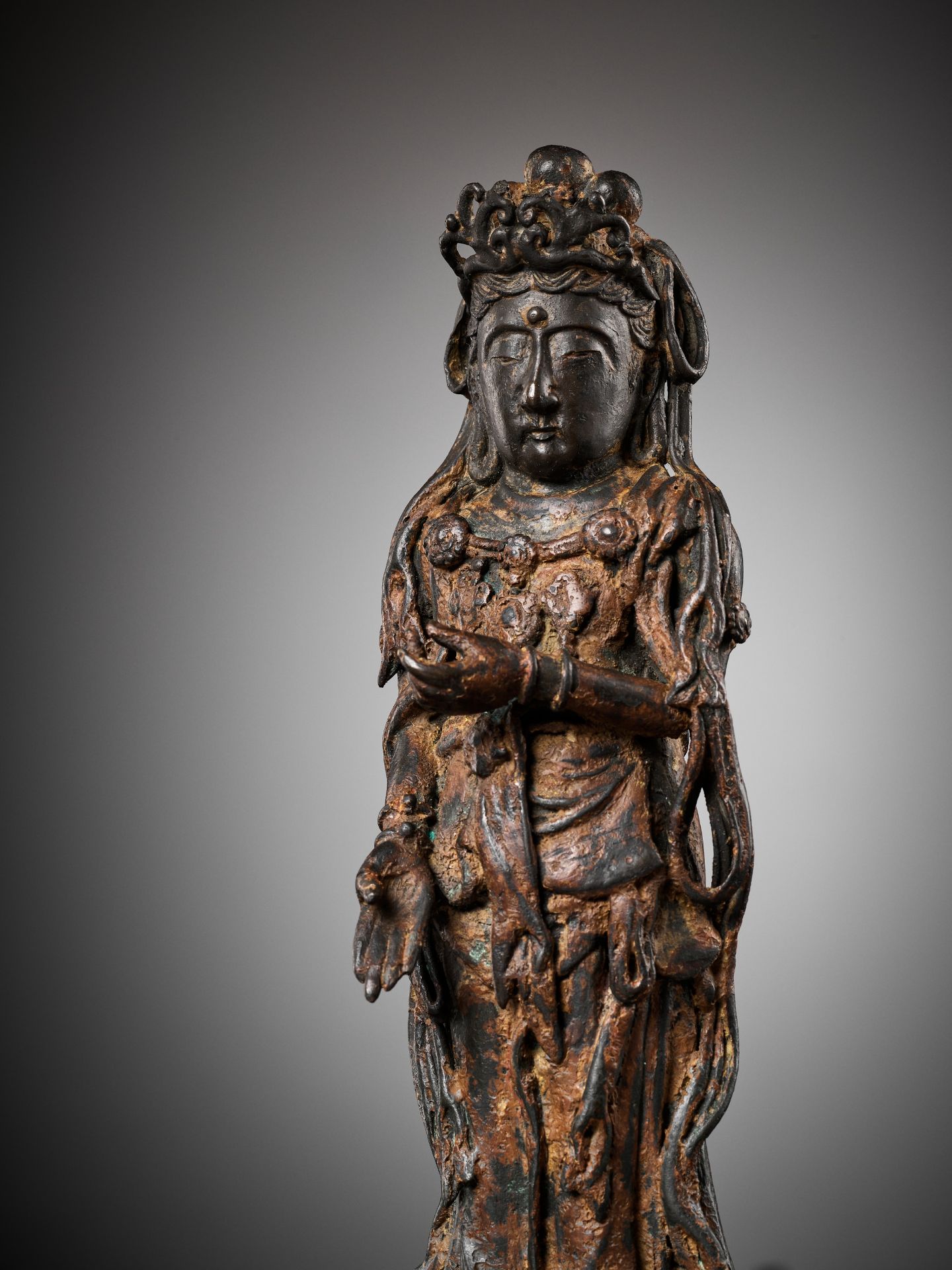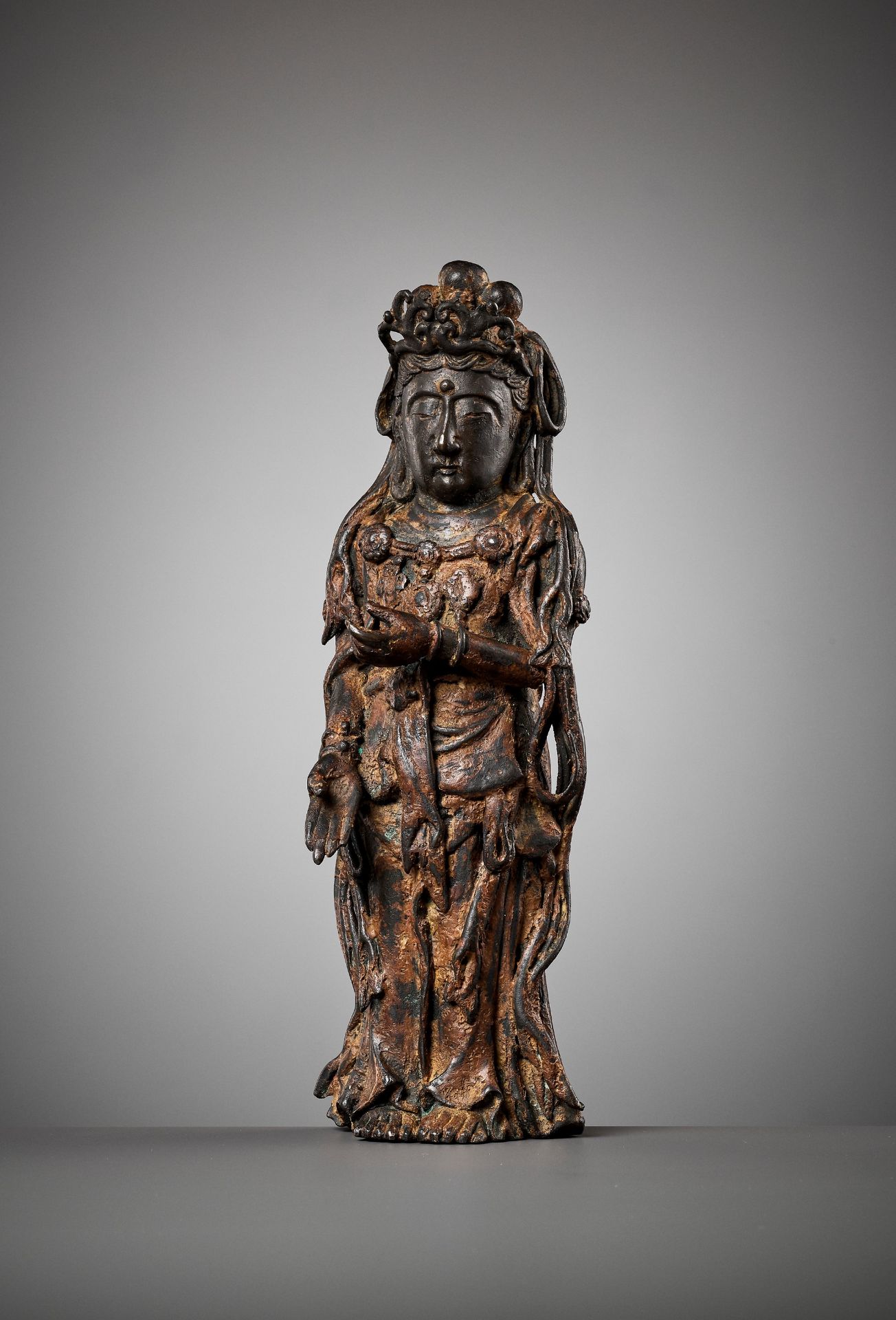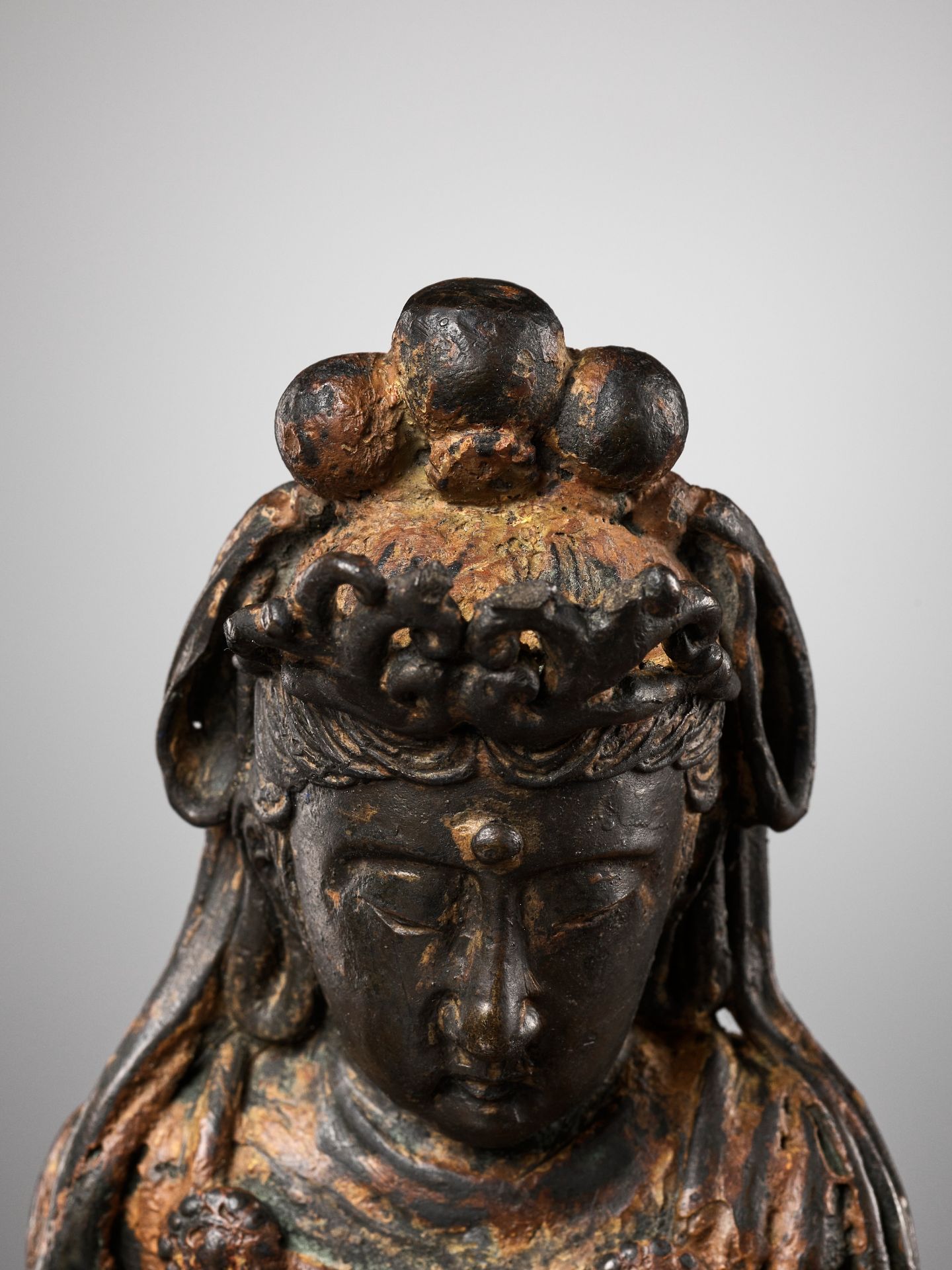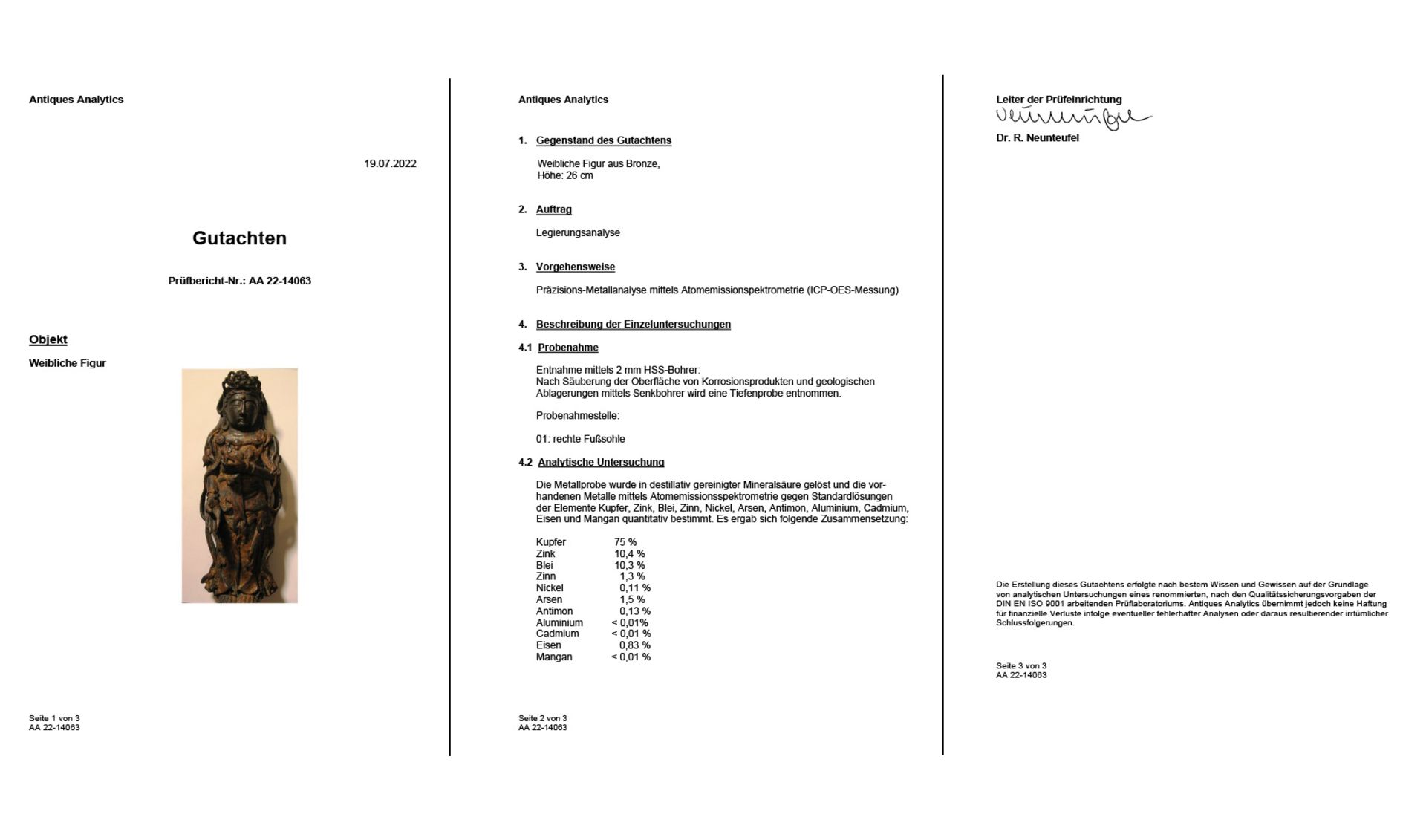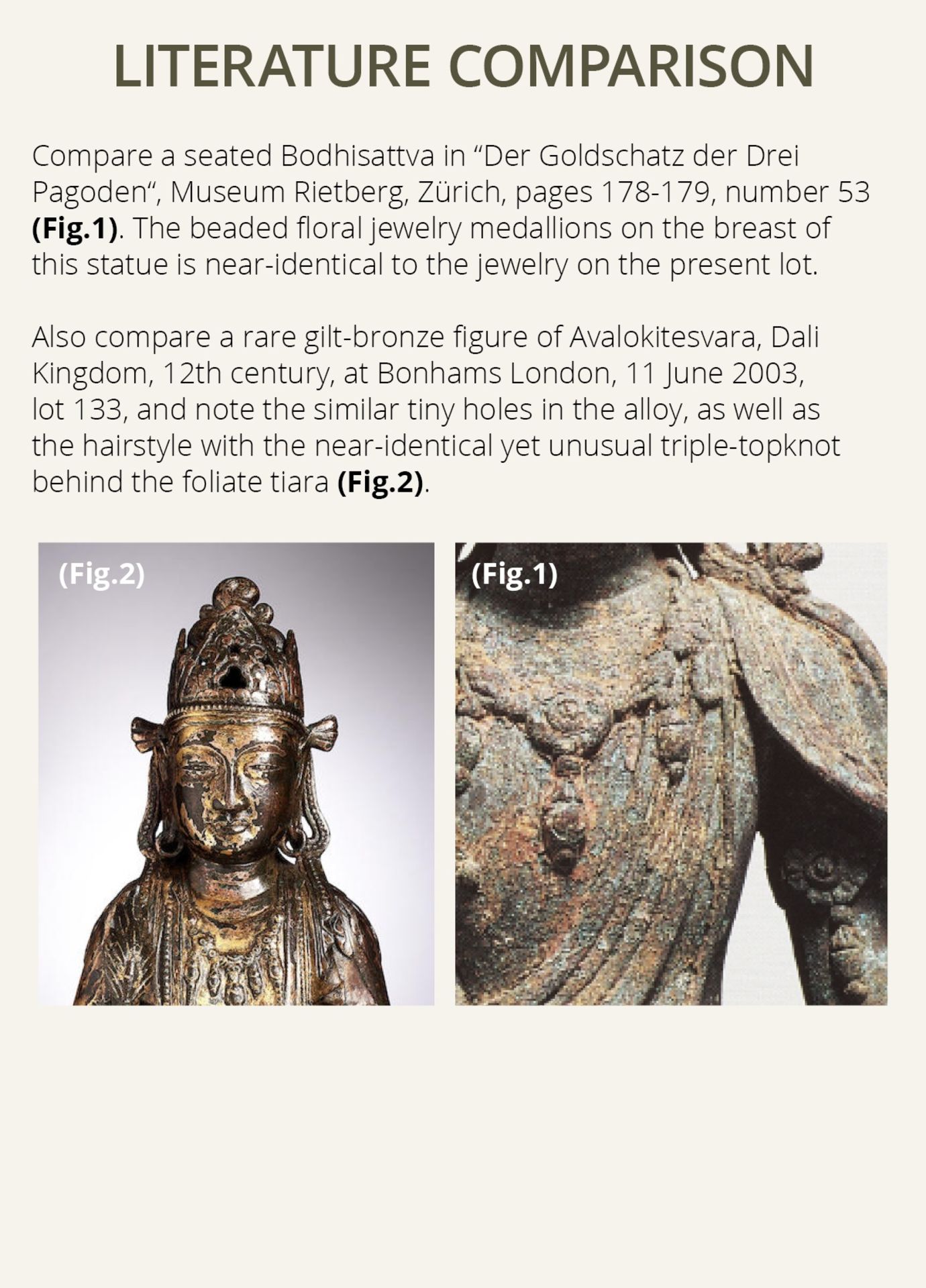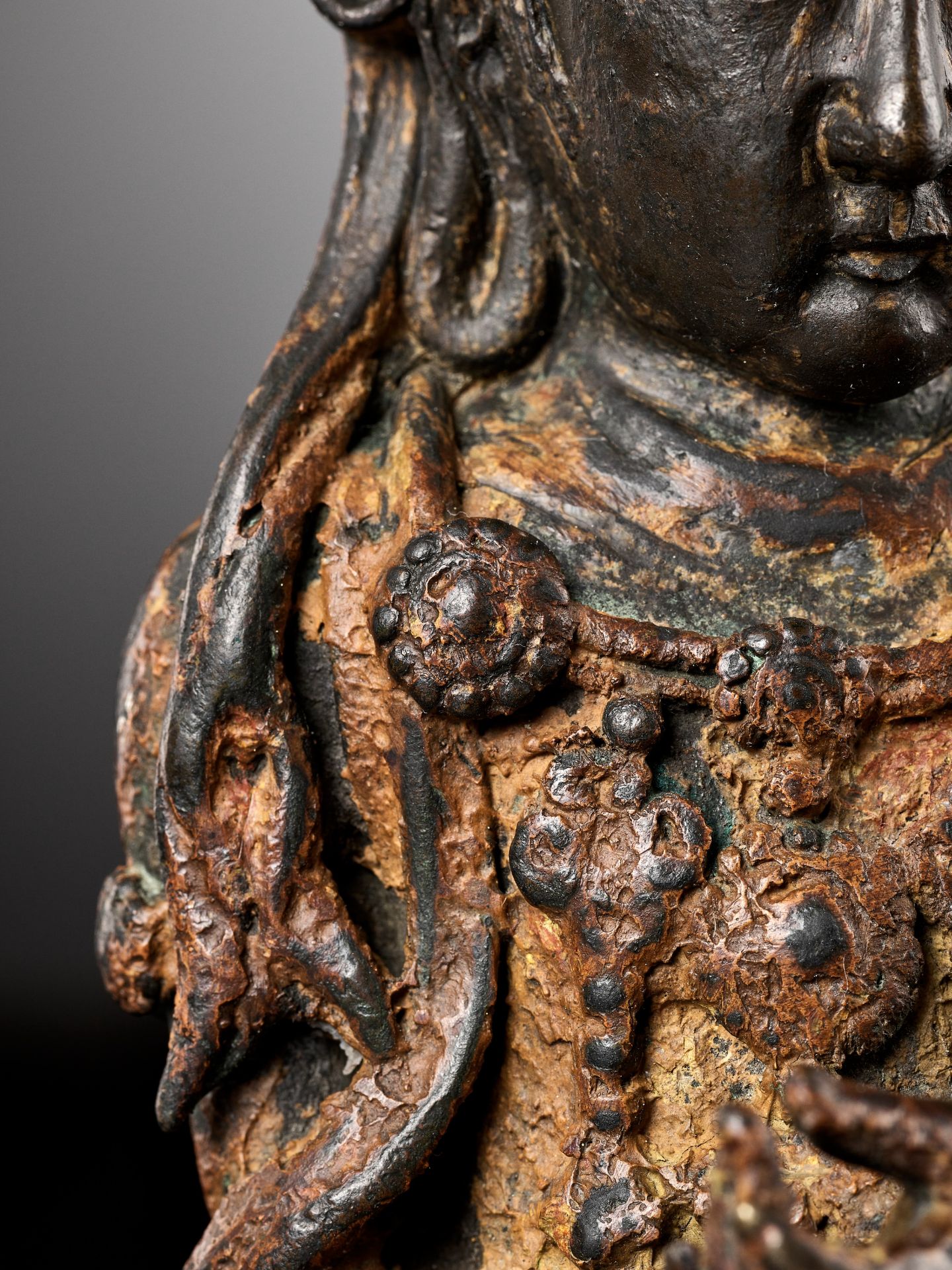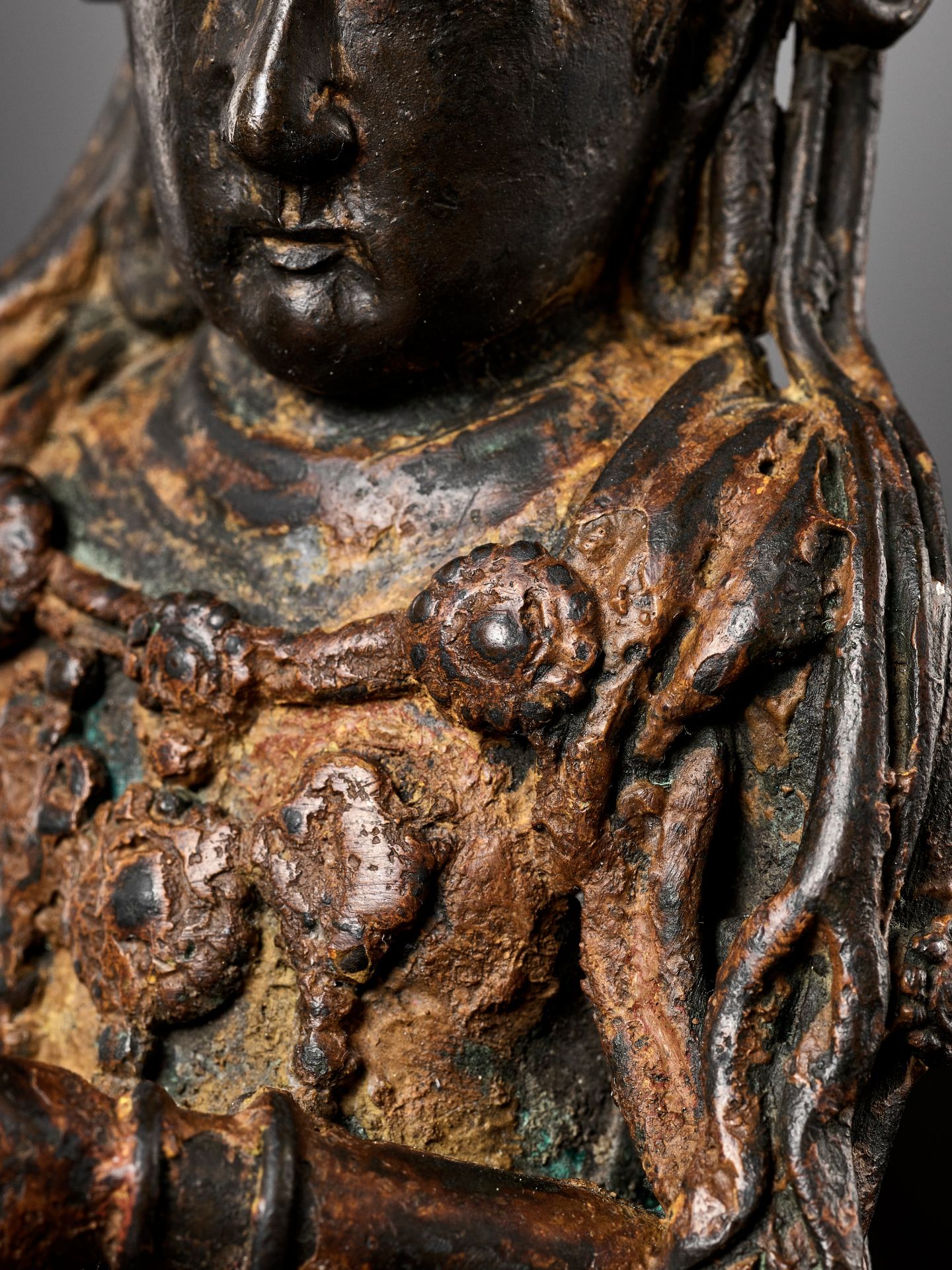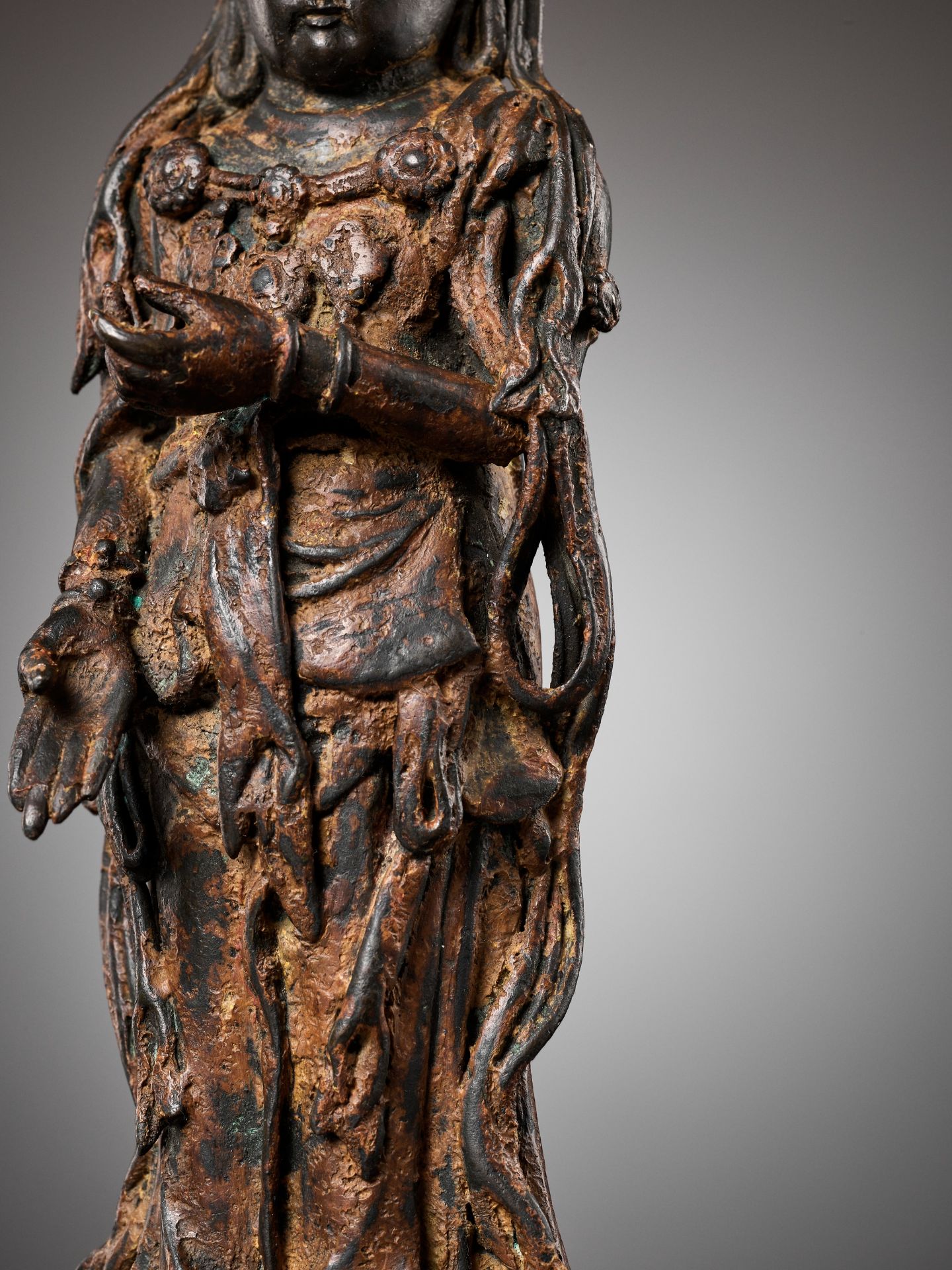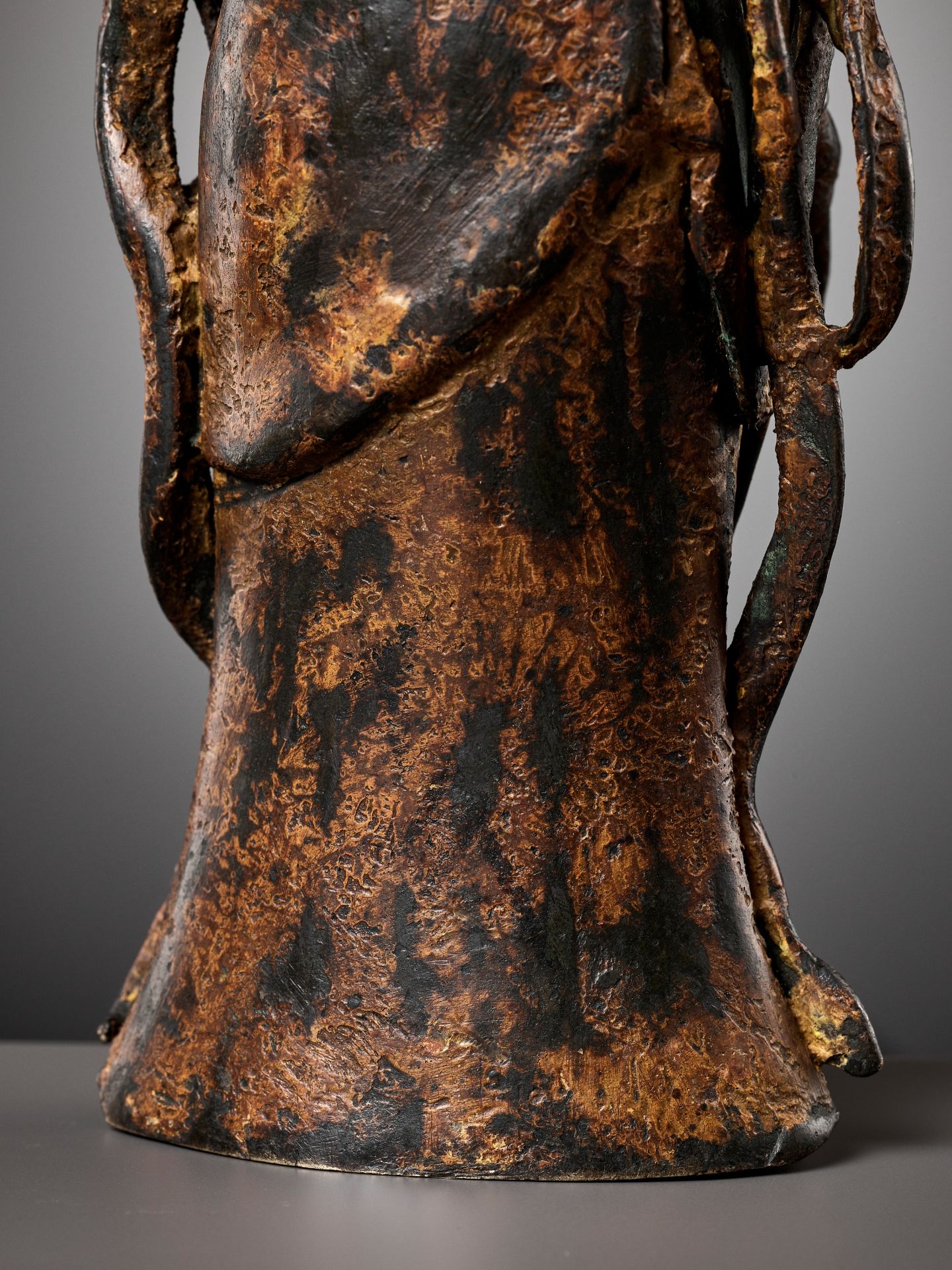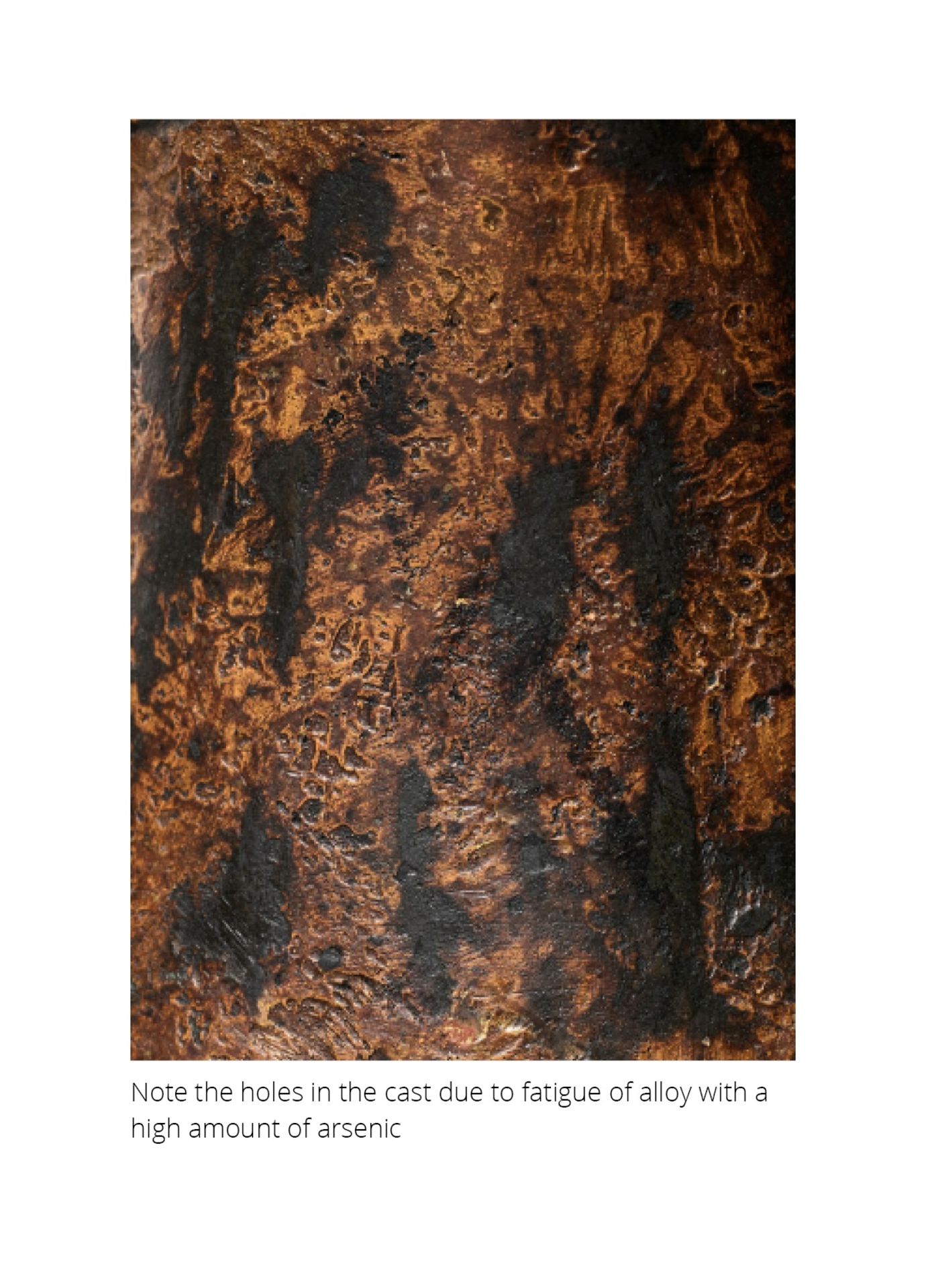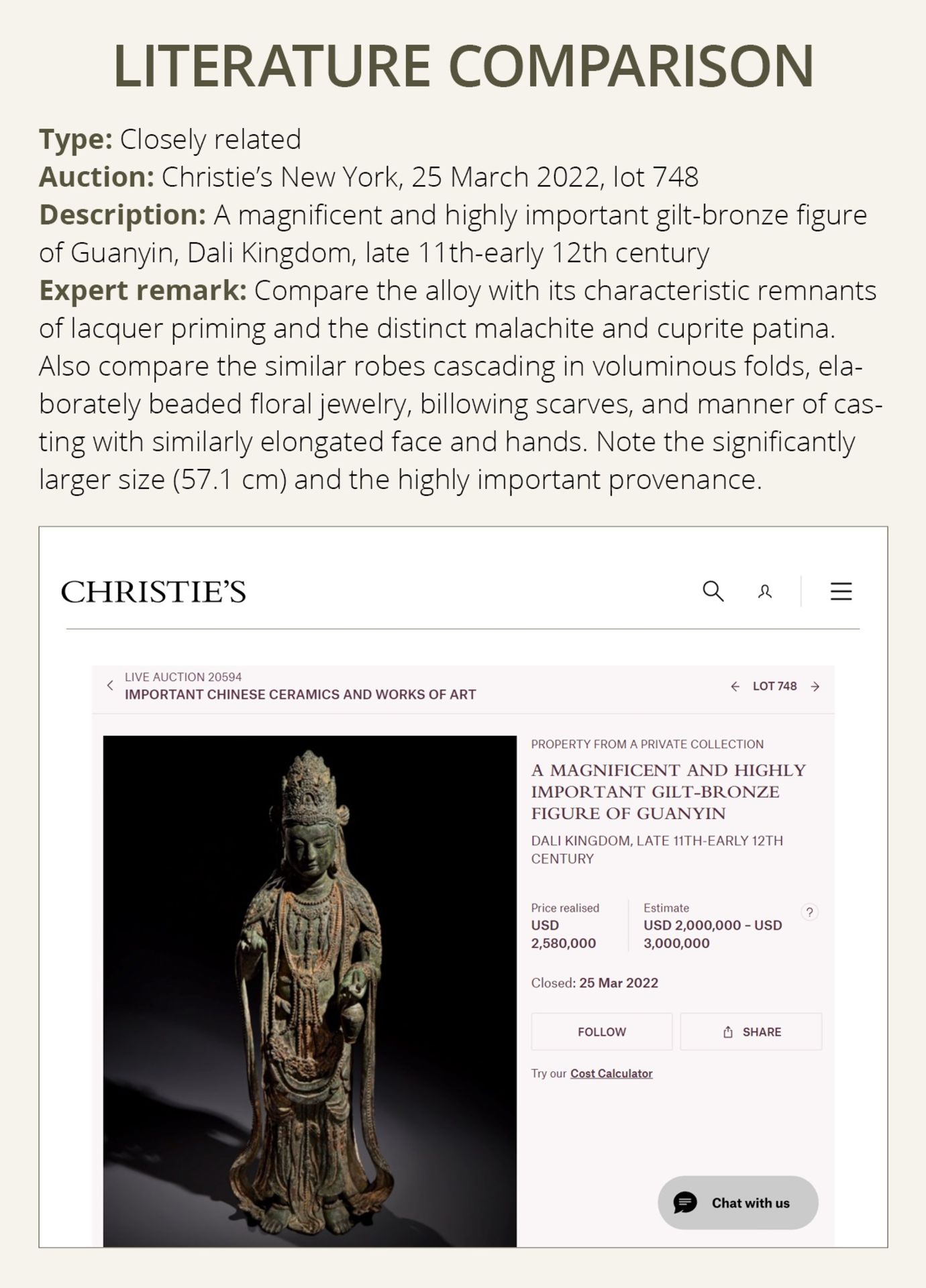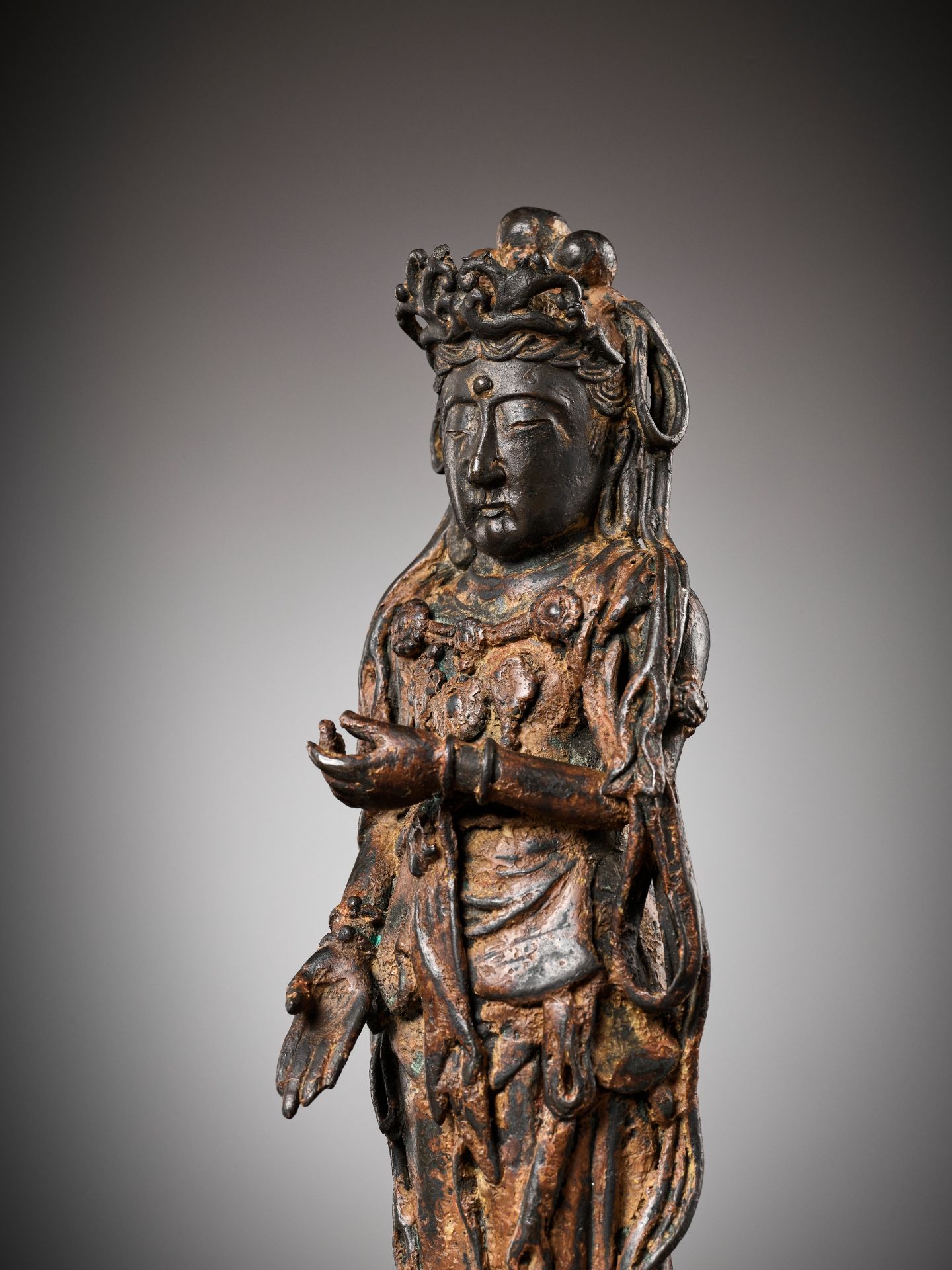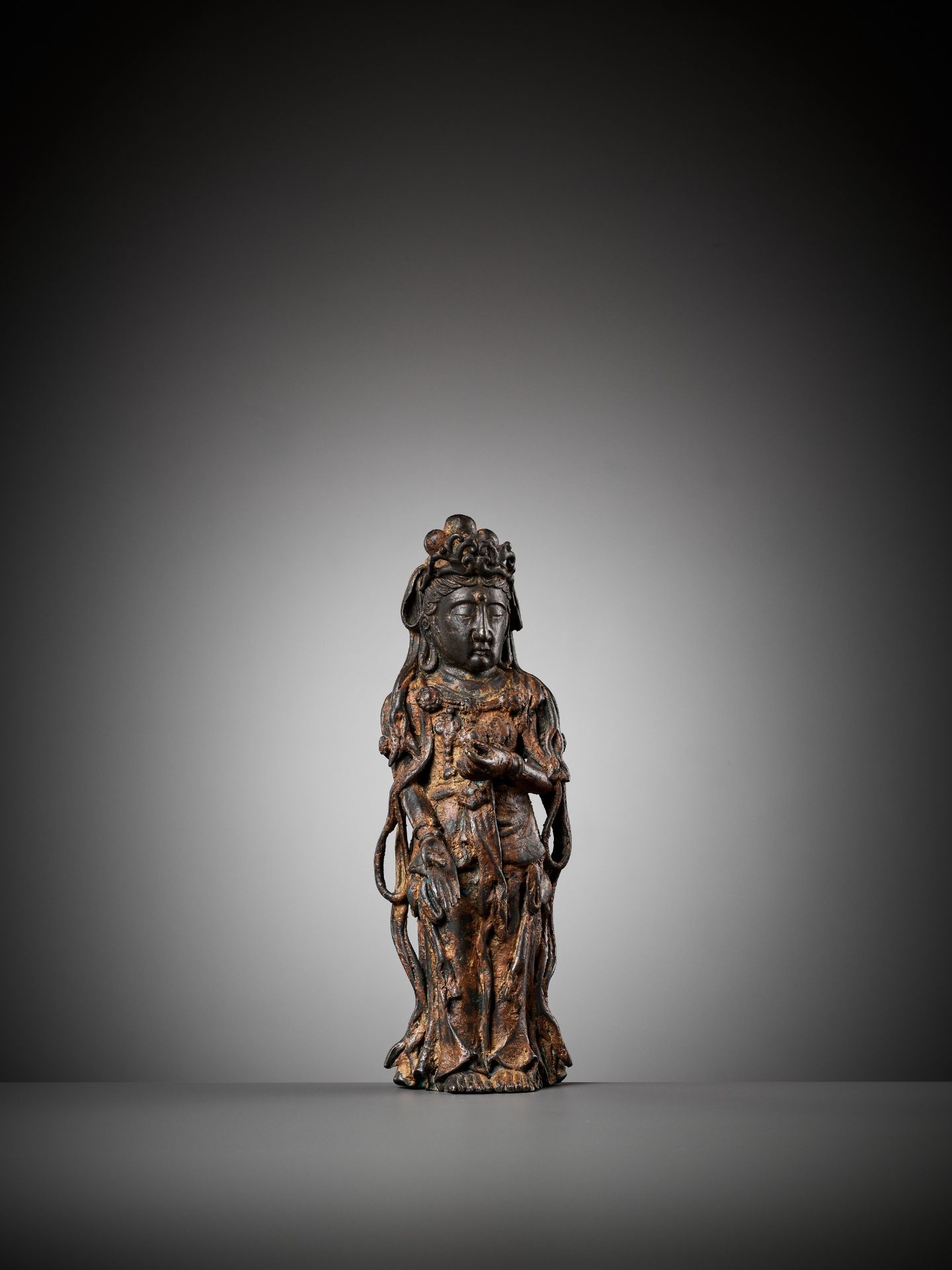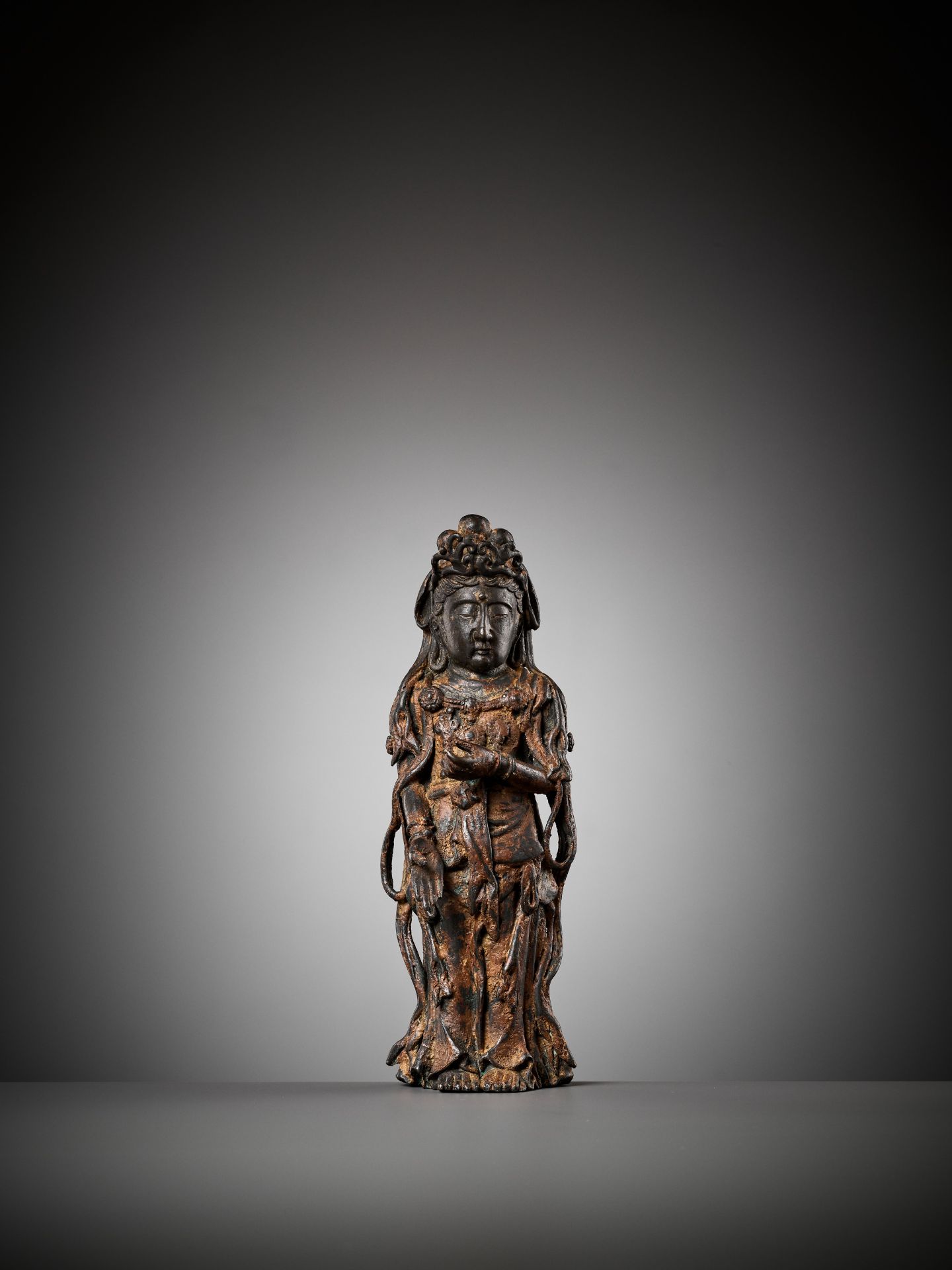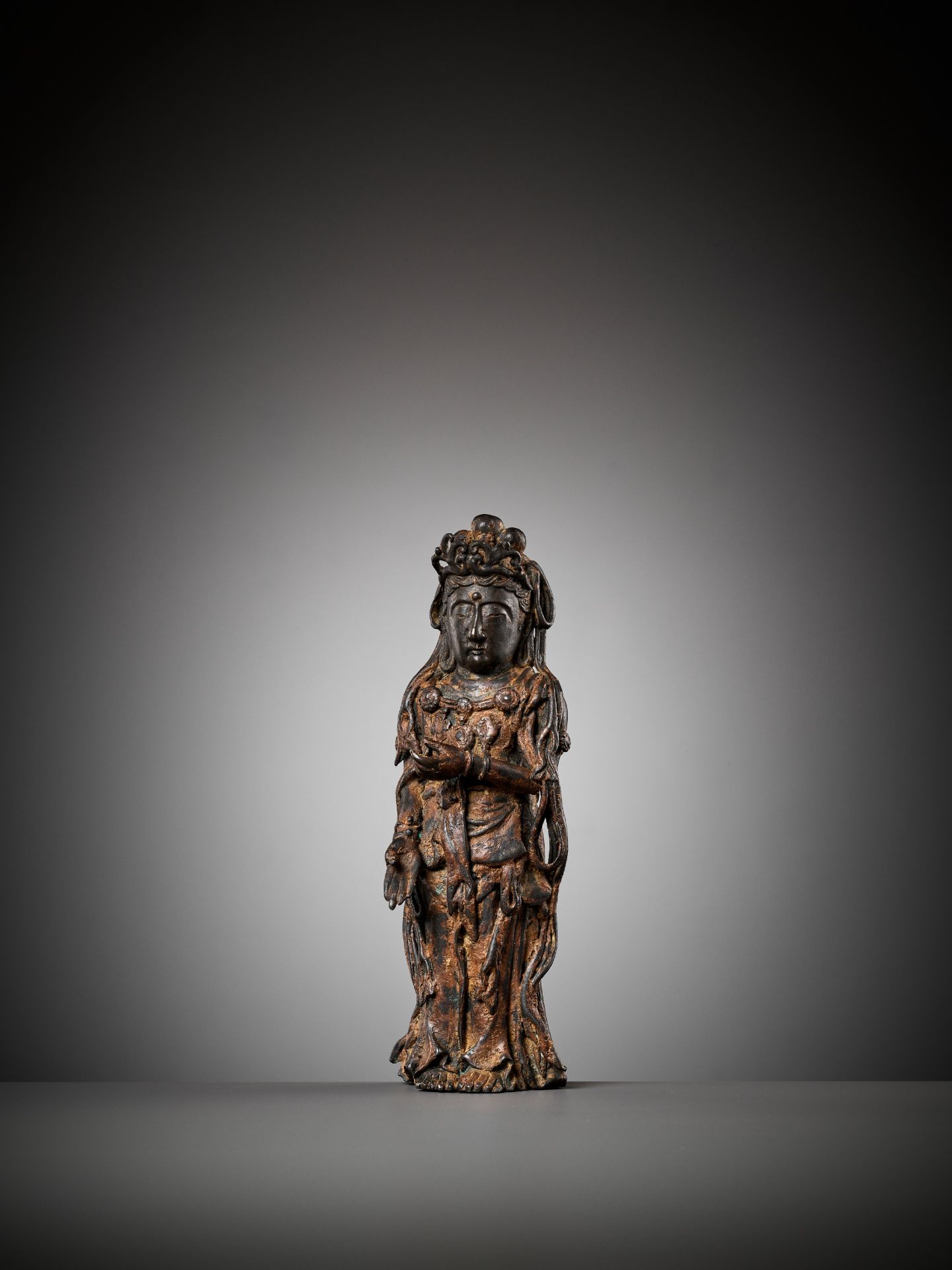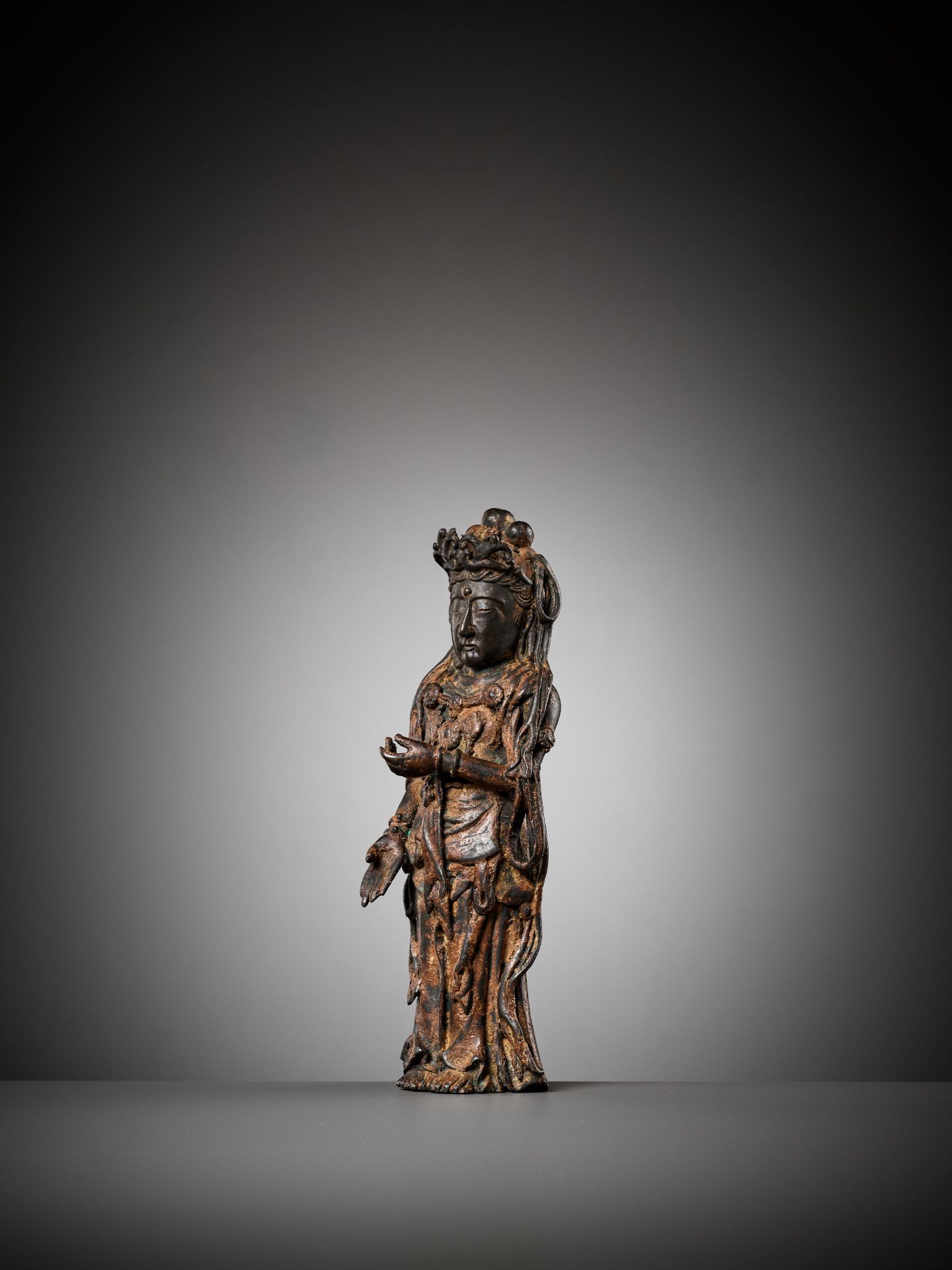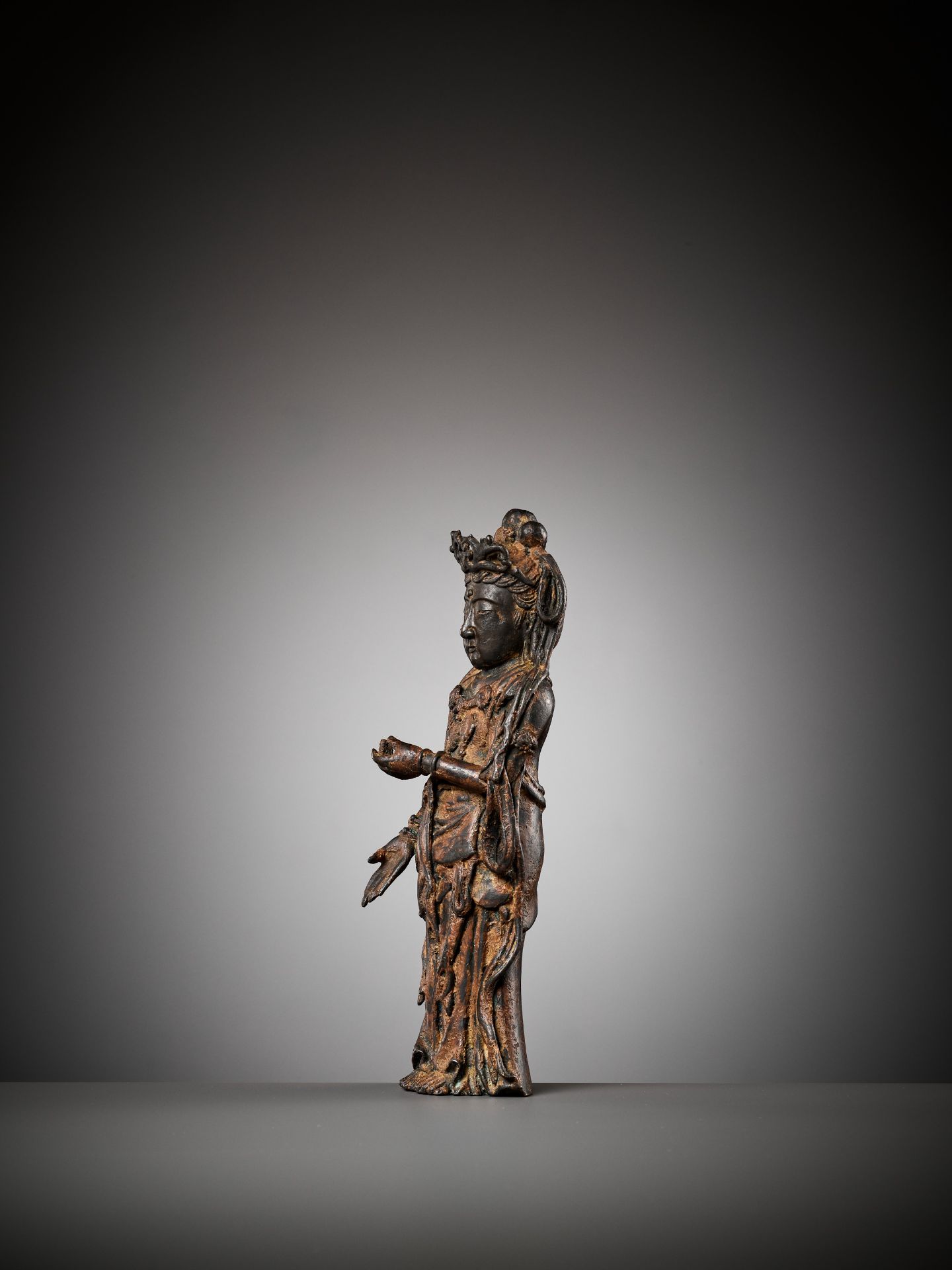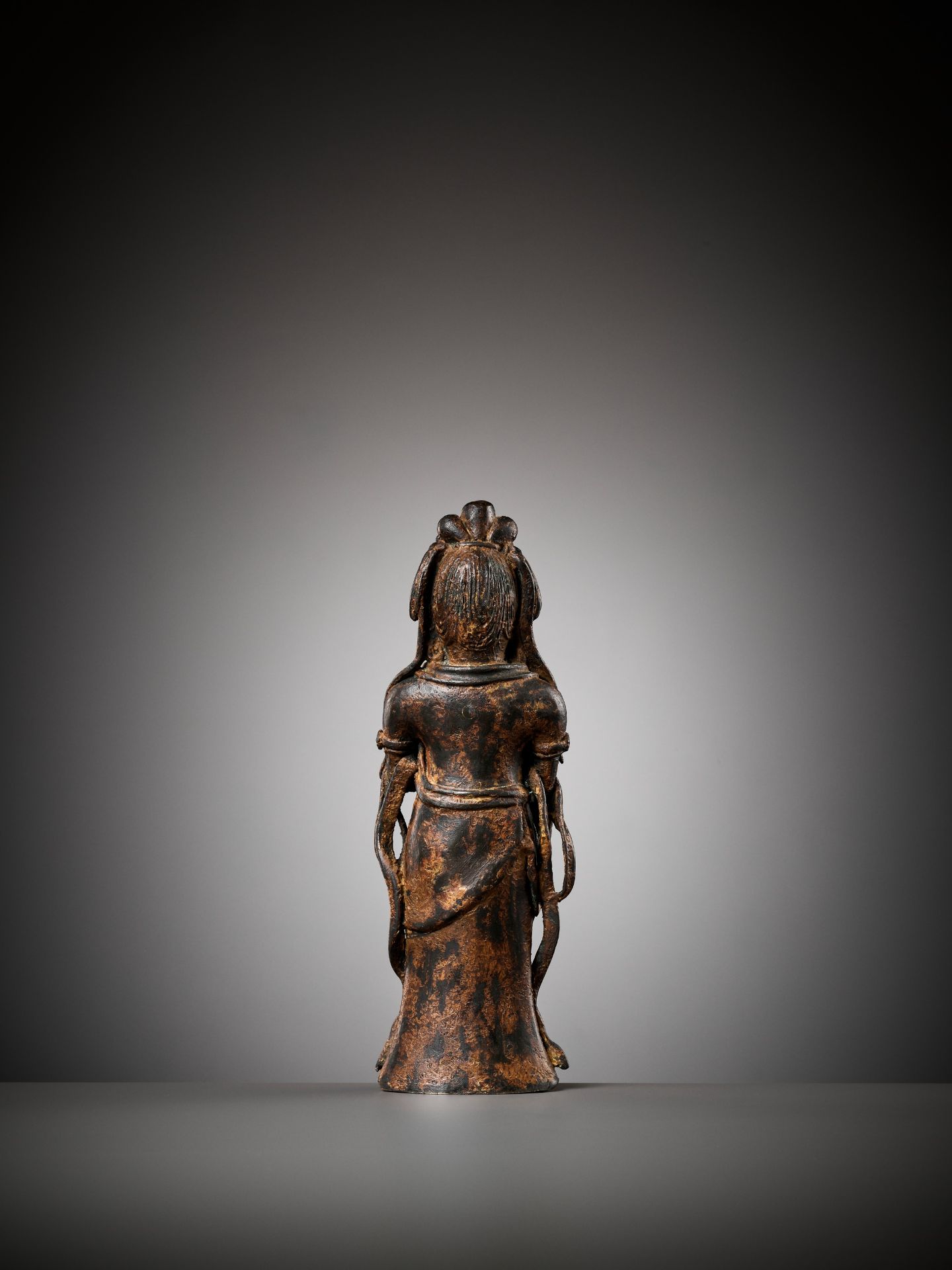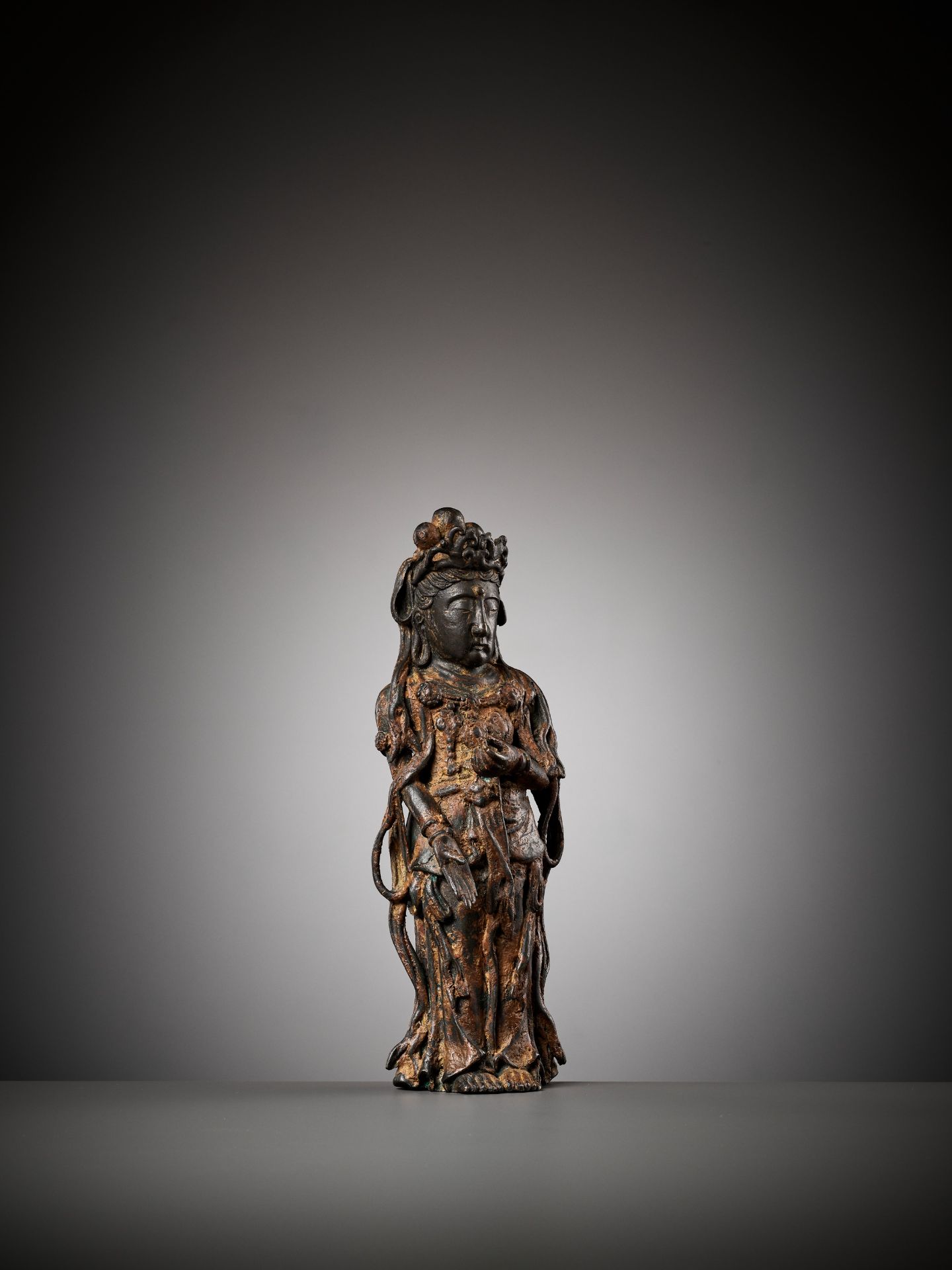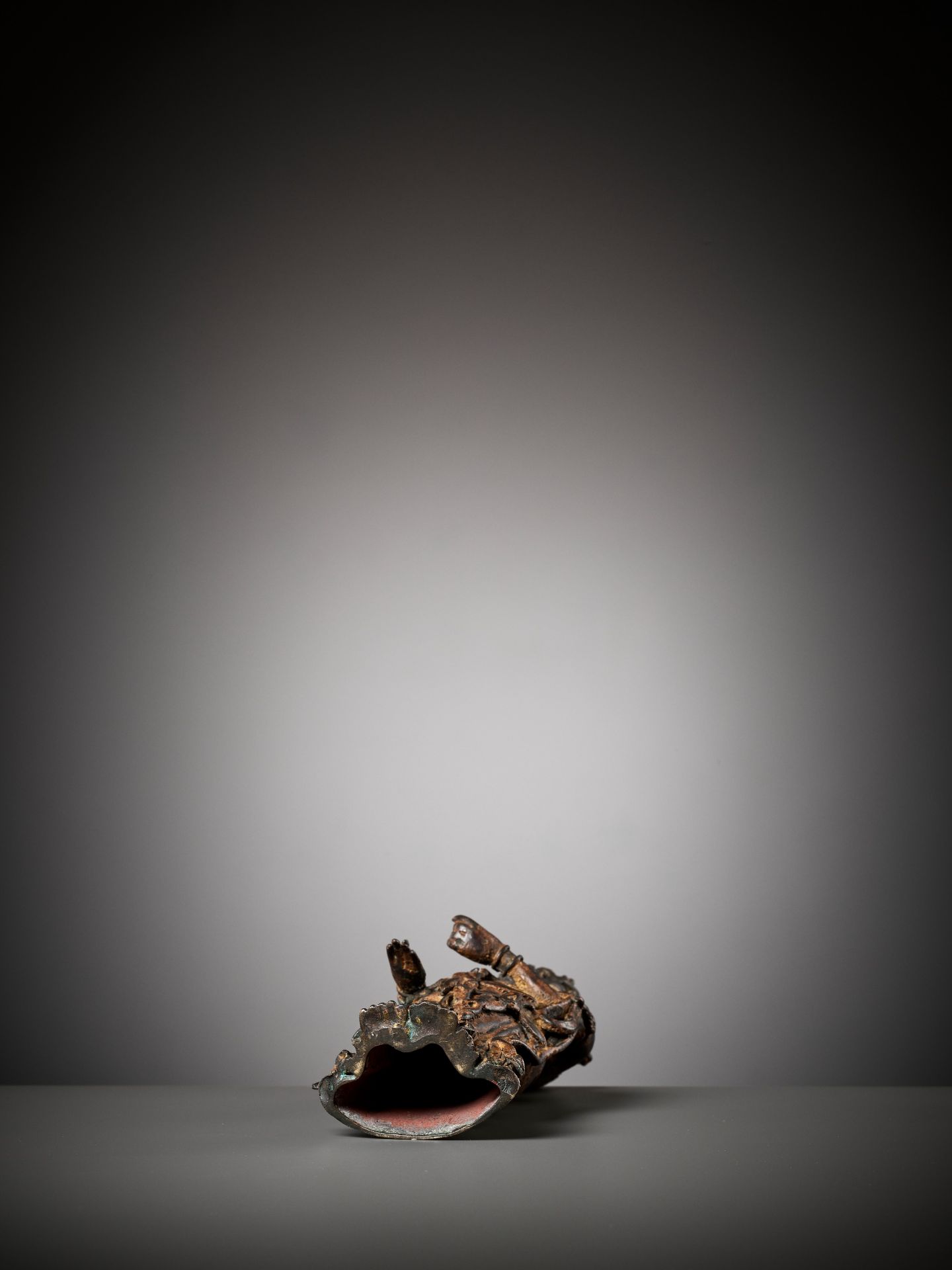143
AN EXCEEDINGLY RARE BRONZE FIGURE OF GUANYIN, DALI KINGDOM, 12TH – MID-13TH CENTURY
AN EXCEEDINGLY RARE BRONZE FIGURE OF GUANYIN, DALI KINGDOM, 12TH – MID-13TH CENTURY
Expert’s note: A unique feature of copper alloys from Yunnan is the high content of arsenic, making the bronze quite soft, and leading to tiny holes in the material. Alloys from other regions do not develop this compelling tell which is clearly visible in the present lot.
A metallurgic analysis of the present lot has shown an arsenic content of 1.5%, which is remarkably elevated. A comprehensive analysis of 32 Chinese copper alloy figures from the collection of the Metropolitan Museum of Art, New York, dating from the 4th to the 19th century, has found that only two statues had an arsenic content of above 1.2%. Both these statues are from Yunnan and date to the 11th-12th century. Only five of the other 30 figures showed an arsenic content between 0,5 and 1,2%, all others were below this value, most of them significantly. (1)
A comprehensive metallurgic analysis of six near-identical copper alloy figures of Acuoye Guanyin from Yunnan in the collections of the Freer Gallery of Art, Washington, the San Diego Museum of Art, the Art institute of Chicago, and the collection of Robert Ellsworth, New York, has returned arsenic contents ranging between 0,53 and 3,08% with an average of 1.89%. (2)
As Paul Jett notes, it seems more likely that the singularly high arsenic content in the copper alloys from Yunnan is of natural origin, instead of being a deliberate addition, because sulfide-deposits, where arsenic appears in combination with copper, are widespread in this specific region. (3)
For the aforementioned reasons, it seems reasonable to assume that copper alloy statues with an elevated arsenic content of 1% or more are from Yunnan when they show stylistic traits characteristic of this region. Features typical of statues from the Dali Kingdom found on the present lot include for example the unusually elongated face, the minuscule yet razor sharp eye slits, the elaborate headdress with its distinct triple-topknot, the beaded floral jewelry medallions on the breast and the lengthy, almost frail hands that still show the undeniable influence of Indian and Southeast Asian Buddhist images, which at that time had already vanished from the more important centers of Chinese Buddhism.
The metallurgic analysis of the present lot furthermore returned a copper share of 75% as well as contents of lead (10%) and zinc (10%). While a zinc content of 10% may be unusual at first glance, it must be noted that coins of the Song dynasty were found to contain Zinc (4) and copper alloys with high levels of zinc eventually became so popular during this period, that they were prohibited by the government for commoners. (5) The Song empire was the eastern neighbor of the Dali Kingdom, and Dali's relationship with the Song was cordial throughout its entire existence, with cultural and economic exchange taking place on multiple levels. In the early Ming dynasty, highly elevated zinc contents of up to 36,4% were found for example in Imperial Xuande period censers dating from 1426-1435. (6)
References:
(1) Wisdom Embodied: Chinese Buddhist and Daoist Sculpture in The Metropolitan Museum of Art, New York, Denise Patry Leidy and Donna Strahan, Yale University Press, 2010, appendix D, pages 206-207.
(2) Der Goldschatz der drei Pagoden, Museum Rietberg Zürich, Albert Lutz, 1991 .Paul Jett: Technologische Studie zu den vergoldeten Guanyin-Figuren aus dem Dali-Königreich, page 73.
(3) Ibidem, page 71.
(4) Distilling Zinc in China: The technology of large-scale zinc production in Chongqing during the Ming and Qing dynasties (AS 1368-1911), Wenli Zhou, University College London, 2012, page 26.
(5) Ibidem, page 39.
(6) Ibidem, page 46-47.
China, Yunnan, Kingdom of Dali, 12th – mid-13th century. Superbly cast standing with her right hand lowered in varada mudra and her left held in front, wearing long flowing robes cascading in voluminous folds and billowing scarves, richly adorned with elaborate beaded and floral jewelry. Her elongated serene face with heavy-lidded, almost fully closed eyes centered by a prominent urna above gently arched brows. The hair falling elegantly in strands over the shoulders and pulled up into a distinct triple-topknot behind the pierced foliate tiara.
Provenance: Old Viennese private collection, built over several generations between 1910 and 1975, thence by descent in the same family.
Condition: Very good condition, commensurate with age and displaying remarkably well. Extensive wear, minor losses, nicks, scratches, minuscule dents, signs of weathering and erosion, remnants of lacquer priming with malachite and cuprite patina.
Weight: 1,458 g
Dimensions: Height 25.8 cm
It was not until the American scholar Helen Chapin identified a group of bronzes in western collections as being of Yunnanese origin, based on a scroll painting known as the Long Scroll of Buddhist Images by the 12th-century Yunnanese artist Zhang Shengwen, which she published in 1944, that the origin of these distinctive Dali or Yunnanese bronzes was first realized. In the late 1970s, restoration work at the Qianxun Pagoda in Yunnan province uncovered a reliquary deposit which included a number of statues similar in style to those in the West, see A. Lutz, 'Buddhist Art in Yunnan', Orientations, February 1992.
Literature comparison:
Compare a seated Bodhisattva in “Der Goldschatz der Drei Pagoden“, Museum Rietberg, Zürich, pages 178-179, number 53 (Fig.1). The beaded floral jewelry medallions on the breast of this statue is near-identical to the jewelry on the present lot. Also compare a rare gilt-bronze figure of Avalokitesvara, Dali Kingdom, 12th century, at Bonhams London, 11 June 2003, lot 133, and note the similar tiny holes in the alloy, as well as the hairstyle with the near-identical yet unusual triple-topknot behind the foliate tiara (Fig.2).
Literature comparison:
Type: Related
Auction: Christie’s New York, 25 March 2022, lot 748
Description: A magnificent and highly important gilt-bronze figure of Guanyin, Dali Kingdom, late 11th-early 12th century
Expert remark: Compare the alloy with its characteristic remnants of lacquer priming and the distinct malachite and cuprite patina. Also compare the similar robes cascading in voluminous folds, elaborately beaded floral jewelry, billowing scarves, and manner of casting with similarly elongated face and hands. Note the significantly larger size (57.1 cm) and the highly important provenance.
大理國罕見觀音銅像
中國,雲南,大理王國,十二世紀至十三世紀中期。該像法相威儀,觀音跣足而立,右手低垂結與願印,左手置於胸前。身著飄逸的長袍,線條流暢,佩戴瓔珞。觀音面部平靜慈祥,雙眼微垂,雙眉之間有白毫。頭髮披肩,葉冠后高髻。
專家注釋:大理國銅器的一個獨特之處是合金中的砷含量高,使銅質變得柔軟,並因合金產生微小的孔洞。後來的銅器和其他地區的銅器沒有這個特徵,這在本拍品和同類銅造像器中清晰可見(見拍賣結果比較)。大理銅造像的風格包括細長的臉、精緻的頭飾和纖柔的手,這些特徵仍然顯示出印度和東南亞佛教造像的影響。
文獻參考:
(1) Denise Patry Leidy,Donna Strahan,《Wisdom Embodied: Chinese Buddhist and Daoist Sculpture in The Metropolitan Museum of Art》,紐約,耶魯大學出版社, 2010年,頁206-207。
(2) Albert Lutz,《Der Goldschatz der drei Pagoden》,蘇黎世Rietberg博物館, 1991年。Paul Jett,《Technologische Studie zu den vergoldeten Guanyin-Figuren aus dem Dali-Königreich》,頁73。
(3) 同上本書,頁71。
(4) Wenli Zhou,《Distilling Zinc in China: The technology of large-scale zinc production in Chongqing during the Ming and Qing dynasties (AS 1368-1911)》,倫敦大學學院2012年,頁26。
(5) 同上本書,頁39。
(6) 同上本書,頁46-47。
AN EXCEEDINGLY RARE BRONZE FIGURE OF GUANYIN, DALI KINGDOM, 12TH – MID-13TH CENTURY
Expert’s note: A unique feature of copper alloys from Yunnan is the high content of arsenic, making the bronze quite soft, and leading to tiny holes in the material. Alloys from other regions do not develop this compelling tell which is clearly visible in the present lot.
A metallurgic analysis of the present lot has shown an arsenic content of 1.5%, which is remarkably elevated. A comprehensive analysis of 32 Chinese copper alloy figures from the collection of the Metropolitan Museum of Art, New York, dating from the 4th to the 19th century, has found that only two statues had an arsenic content of above 1.2%. Both these statues are from Yunnan and date to the 11th-12th century. Only five of the other 30 figures showed an arsenic content between 0,5 and 1,2%, all others were below this value, most of them significantly. (1)
A comprehensive metallurgic analysis of six near-identical copper alloy figures of Acuoye Guanyin from Yunnan in the collections of the Freer Gallery of Art, Washington, the San Diego Museum of Art, the Art institute of Chicago, and the collection of Robert Ellsworth, New York, has returned arsenic contents ranging between 0,53 and 3,08% with an average of 1.89%. (2)
As Paul Jett notes, it seems more likely that the singularly high arsenic content in the copper alloys from Yunnan is of natural origin, instead of being a deliberate addition, because sulfide-deposits, where arsenic appears in combination with copper, are widespread in this specific region. (3)
For the aforementioned reasons, it seems reasonable to assume that copper alloy statues with an elevated arsenic content of 1% or more are from Yunnan when they show stylistic traits characteristic of this region. Features typical of statues from the Dali Kingdom found on the present lot include for example the unusually elongated face, the minuscule yet razor sharp eye slits, the elaborate headdress with its distinct triple-topknot, the beaded floral jewelry medallions on the breast and the lengthy, almost frail hands that still show the undeniable influence of Indian and Southeast Asian Buddhist images, which at that time had already vanished from the more important centers of Chinese Buddhism.
The metallurgic analysis of the present lot furthermore returned a copper share of 75% as well as contents of lead (10%) and zinc (10%). While a zinc content of 10% may be unusual at first glance, it must be noted that coins of the Song dynasty were found to contain Zinc (4) and copper alloys with high levels of zinc eventually became so popular during this period, that they were prohibited by the government for commoners. (5) The Song empire was the eastern neighbor of the Dali Kingdom, and Dali's relationship with the Song was cordial throughout its entire existence, with cultural and economic exchange taking place on multiple levels. In the early Ming dynasty, highly elevated zinc contents of up to 36,4% were found for example in Imperial Xuande period censers dating from 1426-1435. (6)
References:
(1) Wisdom Embodied: Chinese Buddhist and Daoist Sculpture in The Metropolitan Museum of Art, New York, Denise Patry Leidy and Donna Strahan, Yale University Press, 2010, appendix D, pages 206-207.
(2) Der Goldschatz der drei Pagoden, Museum Rietberg Zürich, Albert Lutz, 1991 .Paul Jett: Technologische Studie zu den vergoldeten Guanyin-Figuren aus dem Dali-Königreich, page 73.
(3) Ibidem, page 71.
(4) Distilling Zinc in China: The technology of large-scale zinc production in Chongqing during the Ming and Qing dynasties (AS 1368-1911), Wenli Zhou, University College London, 2012, page 26.
(5) Ibidem, page 39.
(6) Ibidem, page 46-47.
China, Yunnan, Kingdom of Dali, 12th – mid-13th century. Superbly cast standing with her right hand lowered in varada mudra and her left held in front, wearing long flowing robes cascading in voluminous folds and billowing scarves, richly adorned with elaborate beaded and floral jewelry. Her elongated serene face with heavy-lidded, almost fully closed eyes centered by a prominent urna above gently arched brows. The hair falling elegantly in strands over the shoulders and pulled up into a distinct triple-topknot behind the pierced foliate tiara.
Provenance: Old Viennese private collection, built over several generations between 1910 and 1975, thence by descent in the same family.
Condition: Very good condition, commensurate with age and displaying remarkably well. Extensive wear, minor losses, nicks, scratches, minuscule dents, signs of weathering and erosion, remnants of lacquer priming with malachite and cuprite patina.
Weight: 1,458 g
Dimensions: Height 25.8 cm
It was not until the American scholar Helen Chapin identified a group of bronzes in western collections as being of Yunnanese origin, based on a scroll painting known as the Long Scroll of Buddhist Images by the 12th-century Yunnanese artist Zhang Shengwen, which she published in 1944, that the origin of these distinctive Dali or Yunnanese bronzes was first realized. In the late 1970s, restoration work at the Qianxun Pagoda in Yunnan province uncovered a reliquary deposit which included a number of statues similar in style to those in the West, see A. Lutz, 'Buddhist Art in Yunnan', Orientations, February 1992.
Literature comparison:
Compare a seated Bodhisattva in “Der Goldschatz der Drei Pagoden“, Museum Rietberg, Zürich, pages 178-179, number 53 (Fig.1). The beaded floral jewelry medallions on the breast of this statue is near-identical to the jewelry on the present lot. Also compare a rare gilt-bronze figure of Avalokitesvara, Dali Kingdom, 12th century, at Bonhams London, 11 June 2003, lot 133, and note the similar tiny holes in the alloy, as well as the hairstyle with the near-identical yet unusual triple-topknot behind the foliate tiara (Fig.2).
Literature comparison:
Type: Related
Auction: Christie’s New York, 25 March 2022, lot 748
Description: A magnificent and highly important gilt-bronze figure of Guanyin, Dali Kingdom, late 11th-early 12th century
Expert remark: Compare the alloy with its characteristic remnants of lacquer priming and the distinct malachite and cuprite patina. Also compare the similar robes cascading in voluminous folds, elaborately beaded floral jewelry, billowing scarves, and manner of casting with similarly elongated face and hands. Note the significantly larger size (57.1 cm) and the highly important provenance.
大理國罕見觀音銅像
中國,雲南,大理王國,十二世紀至十三世紀中期。該像法相威儀,觀音跣足而立,右手低垂結與願印,左手置於胸前。身著飄逸的長袍,線條流暢,佩戴瓔珞。觀音面部平靜慈祥,雙眼微垂,雙眉之間有白毫。頭髮披肩,葉冠后高髻。
專家注釋:大理國銅器的一個獨特之處是合金中的砷含量高,使銅質變得柔軟,並因合金產生微小的孔洞。後來的銅器和其他地區的銅器沒有這個特徵,這在本拍品和同類銅造像器中清晰可見(見拍賣結果比較)。大理銅造像的風格包括細長的臉、精緻的頭飾和纖柔的手,這些特徵仍然顯示出印度和東南亞佛教造像的影響。
文獻參考:
(1) Denise Patry Leidy,Donna Strahan,《Wisdom Embodied: Chinese Buddhist and Daoist Sculpture in The Metropolitan Museum of Art》,紐約,耶魯大學出版社, 2010年,頁206-207。
(2) Albert Lutz,《Der Goldschatz der drei Pagoden》,蘇黎世Rietberg博物館, 1991年。Paul Jett,《Technologische Studie zu den vergoldeten Guanyin-Figuren aus dem Dali-Königreich》,頁73。
(3) 同上本書,頁71。
(4) Wenli Zhou,《Distilling Zinc in China: The technology of large-scale zinc production in Chongqing during the Ming and Qing dynasties (AS 1368-1911)》,倫敦大學學院2012年,頁26。
(5) 同上本書,頁39。
(6) 同上本書,頁46-47。
Fine Chinese Art / 中國藝術集珍 / Buddhism & Hinduism
Auktionsdatum
Ort der Versteigerung
Für Galerie Zacke Versandinformtation bitte wählen Sie +43(0)-15320452.
Wichtige Informationen
Contact us via Wechat, our Wechat ID: GalerieZacke
We’ve updated our terms and conditions to better protect all serious and committed buyers from bidding against non-payers. Bidders must clarify all questions specifically about the objects before the auction. A sale cancellation of any kind after the fall of the hammer is not possible. The only exception to this fundamental rule is our guarantee of authenticity. We encourage you to read through these updates carefully (§34-50).
According to the general terms and conditions of business of Galerie Zacke Vienna, Founded 1968, SZA Versteigerungen & Vertriebs GmbH, 1070 Wien
WE ACCEPT THE FOLLOWING METHODS OF PAYMENTS:
• Cash
• Certified or personal check
• Bank transfer (please inquire to receive our bank account information)
• Credit card (Visa, MasterCard, Amex, Diners Club)
ESTIMATES AND STARTING PRICES
The auction will begin with the starting price and written bids will be accepted only with a minimum amount equivalent to the starting price.
SHIPPING AND TRANSPORT INSURANCE
For domestic shipping Galerie Zacke (hereinafter called “the company”) charges in average Eur 15,- to Eur 50,- per item, depending on size and weight. These fees cover the costs of packing and shipping. Fees for bulky or fragile items, or international shipping will be quoted upon request.
The purchased goods are transported at the risk of the customer following handover of the packaged item to the post office or another carrier which the customer agrees to through his/her submission of the purchase order. According to the specific wish of the customer, the auctioned goods may be insured for the value of the purchase price (highest bid and all surcharges). This insurance fee is 3% of the purchase price. For any lots with a purchase prices exceeding EUR 350,- the transport insurance will be automatically arranged by the company if it does not expressively receive the purchaser’s written denial of this service and signed waiver of claims. Payments due to the company under the insurance contract will be charged to the customer. The company is also entitled to assign claims under the insurance contract to the customer providing the terms of the insurance contract do not prevent this. In any case, the company is only required to make payment to the customer specifically if payment has effectively been received from the insurance company.
COLOR AND CONDITION
Auction lots will be exhibited for viewing prior to the auction, thus offering all interested customers the opportunity to examine the quality and condition of the works exhibited. The catalog illustrations are intended to assist customers during such preview. In illustrations, printed colors do not correspond exactly to the originals. The printed catalog images are not representative for the condition of the illustrated pieces. Hidden flaws and damages are indicated in the condition report. The illustrations in our online catalogs can be strongly magnified, so that most damages and restorations are well recognizable.
ENDANGERED SPECIES / CITES INFORMATION
Some items in this catalog may for example consist of ivory, rhinoceroshorn, tortoise shell, or some types of tropical wood, and are subject to the Convention on International Trade in Endangered Species of Wild Fauna and Flora [CITES]. Such items are marked with the symbol Ɏ on www.zacke.at and may only be exported outside the European Union after an export permit in accordance with CITES has been granted by the Austrian authorities. We would like to inform you that such licenses are typically not granted. For objects which have a low ivory content or have been proven beyond doubt to be in the EU before 1982, please contact our office for more information on how to obtain a CITES license.
COMPLAINTS
At its auctions, Galerie Zacke sells consigned lots on behalf of third-party consignors. For this reason, any complaints related to purchased lots must be in accordance with §32-48 of the general terms and conditions of business of Galerie Zacke, which can be found on www.zacke.at
IMPORTANT INFORMATION
Whenever making a bid, whether personally or via an agent, in writing, online, telephone, or in any other way, the bidder fully and unconditionally accepts the Terms of Auction, the ‘Important Information’ section in the auction catalog, the Terms and Conditions (AGB) of Galerie Zacke, §1-48, the Fee Tariff, and the Bidding Increments table, all as published on www.zacke.at on the day of the auction
THE ART LOSS REGISTER
All items starting above 2.000,- EUR have been checked by the Art Loss register
AGB
TERMS OF AUCTION
Buyer’s Premium 30% including VAT
Further information please read § 3
§ 1) The auction shall be carried out in accordance with the provisions of the rules of procedure of GALERIE ZACKE©, SZA VERSTEIGERUNGEN UND VERTRIEBS GMBH, MARIAHILFERSTRASSE 112, 1070 WIEN (hereinafter referred to as the company) as well as in accordance with sections 244-246 of the GEWERBEORDNUNG [Industrial Code] of 1994. The auction shall be carried out on commission. The auctioneer shall be entitled to withdraw lots exceptionally, to conduct the auction deviating from the order of the catalog numbers and to offer lots jointly. In the event of any dispute concerning a double bid or if the auctioneer has missed a bid, the auctioneer shall be entitled to revoke acceptance of a bid and to continue auctioning the item. The figures stated in the catalog shall be the highest bid in Euro (€) expected by the respective expert. As a rule, the bid shall be increased by 10% of the last bid. (See table of the bidding increments).
§ 2) The acceptance of a bid shall be granted to the highest bidder unless a hidden reserve has been agreed upon with the consignor of the item in question. Such a hidden reserve (also called limit or just reserve) shall be the minimum price under which the item will not be sold during the auction. This reserve will be disclosed upon request and after the auction only and may exceed the estimate. The auctioneer will in this case bid on behalf of the seller against all other bidders until the reserve has been reached. If a reserve is not reached during the auction, the auctioneer will knock down the item to the highest bidder at the final bid, but the sale will be conditional of the acceptance of this final bid by the seller. In this case the highest bidder shall be bound to his/her last bid for a term of 8 days starting with the day of the knockdown. If the winning bidder does not receive a written cancellation notice within this term of 8 days, the knockdown becomes unconditional and the sale is final. Typically, only a minority of all items in an auction have a hidden reserve.
§ 3) Most items shall be subject to differential taxation. A uniform surcharge of 25% plus the value added tax applicable to the surcharge to the amount of 20% shall be added to the achieved highest bid (final and highest bid). Thus, the surcharge shall be 30% of the final and highest bid in total. Items with added VAT are marked in the online catalog.
§ 4) In the event of sales abroad, the value added tax will be repaid if the item is sold to a country which is not a member country of the European Union (third country), the legal requirements are met, and the proof of exportation is provided. The value added tax shall not be shown separately on the invoice.
§ 5) The auction buyer must pay the purchase price immediately upon acceptance of the bid (final and highest bid plus 25% surcharge, plus the value added tax applicable to the surcharge to the amount of 20%, or the added VAT on top of the final price, when a lot is highlighted accordingly in the auction catalog). The company may grant an auction buyer a term of payment for the purchase price in whole or in part when this has been formally applied for in writing before the auction.
§ 6) In the event of a term of payment, or any payment delay, in whole or in part, the company shall be entitled to charge default interest (12% p.a.) as well as storage charges (2.4% pf the final and highest bid per month commenced) after 14 days upon acceptance of the bid. The item purchased at auction shall be handed over exclusively upon full payment of the purchase price including all costs and charges accrued since the acceptance of the bid.
§ 7) The buyer should take acquired items into possession, as far as possible, immediately or after the end of the auction. Items which have been fully paid for shall be handed over in our show rooms in GALERIE ZACKE, MARIAHILFERSTRASSE 112, 1070 VIENNA. If a deferred purchase price is not paid within the set period, the company shall be entitled to auction the item again in order to recoup its claim from the defaulting auction buyer. In this case, the defaulting auction buyer shall be liable to the company for the total loss of commission incurred by the company due to the re-auctioning as well as for any default interest and storage charges.
§ 8) The company shall be entitled to a lien on all items of the buyer irrespective of whether the buyer bought them within the scope of an auction or in free sale or the company secured ownership of these items otherwise. This lien shall serve to secure all current and future, qualified, limited and unmatured claims to which the company is entitled and which result from all legal transactions concluded with the buyer.
§ 9) The items received for auction will be exhibited and may be viewed prior to the auction. In doing so, the company shall give everyone the opportunity to check the nature and the condition of the exhibited items to the extent deemed possible within the scope of the exhibition. Every bidder shall be deemed to act on its own behalf unless it provides a written confirmation saying that it acts as a representative or agent of a well-known principal. The company may refuse bids; this shall particularly apply if a bidder who is unknown to the company or with whom the company has no business connections yet does not provide a security deposit before the auction. However, in principle there shall be no claim to accept a bid. If a bid has been refused, the previous bid shall remain effective.
§ 10) The company’s experts evaluate and describe the items received for auction and determine the starting prices unless otherwise stated in the catalog or expert opinion. The information concerning production technique or material, state of preservation, origin, design and age of an item is based on published or otherwise generally accessible (scientific) findings concluded by the company’s expert with the necessary care and accuracy. The company shall warrant to the buyer according to §34-38 of the AGB (Terms and Conditions) that properties are correct provided that any complaints referring to this are made within 45 days after the auction day. Subsequent complaints shall be excluded in principle. The company shall not be liable for any further information in the catalog and expert opinion as well. This shall also apply to illustrations in the catalog. The purpose of these illustrations is to guide the potential buyer during the preview. They shall not be authoritative for the condition or the characteristics of the pictured item. The published condition reports shall only mention defects and damage affecting the artistic or commercial value significantly. Complaints concerning the price shall be excluded upon acceptance of the bid. The company reserves the right to amend the catalog online prior to the auction. These amendments shall also be made public orally by the auctioneer during the auction. In this case, the company shall be liable for the amendment only. All items offered may be checked prior to the auction. These items are used. Any claims for damages exceeding the liability named above and resulting from other material defects or other defects of the item shall be excluded. When making the bid, the bidder confirms that he/she has inspected the item prior to the auction and has made sure that the item corresponds to the description.
§ 11) If a customer is not able to participate in an auction personally, the company shall accept purchase orders. These orders may be placed in writing via mail, e-mail, fax, www.zacke.at or a third party bidding platform. In the case of a purchase order placed by phone or orally, the company shall reserve the right to make the performance dependent on a confirmation from the principal communicated in writing. Furthermore, the company shall not be liable for the performance of purchase orders. Equal purchase orders or live bids will be considered in the order of their receipt. Bids which below the estimate shall be exhausted completely. Bids which do not correspond to the increments determined by the company (see bidding increment table) will be rounded up to the next higher increment. The table of these increments can be sent upon request. The written bid (purchase order) must include the item, the catalog number and the offered top bid limit which is quoted as the amount of the acceptance of the bid without buyer’s commission and without taxes. Ambiguities shall be carried by the bidder. A purchase order which has already been placed may only be cancelled if the written withdrawal is received by the company at least 72 hours prior to the beginning of the auction.
§ 12) The company may refuse a purchase order without explanation or make its execution dependent on payment of a security deposit. In the event of an unsuccessful order, such a deposit will be reimbursed by the company within 5 working days. Processing of purchase orders is free of charge.
§ 13) Every seller shall in principle be entitled to withdraw the items offered for auction until the start of the auction. Therefore, it is impossible to assume liability or to give warranty for the actual offering.
§ 14) Paid items must be collected within 30 days after payment. Items which have not been collected may be re-offered without further communication at the starting price from the recent auction reduced by 50%. Items which have not been collected within 30 days after the auction or for which the company does not receive any proper shipping instructions stating the type of shipping and the address of dispatch (independent of a possibly placed purchase order) shall be stored at the owner’s risk. Furthermore, the company shall be entitled to store items which have been purchased at auction and paid but not collected at the buyer ś risk and expense, including the costs for an insurance, with a forwarding agency. It shall be understood that the provision concerning the re-auctioning of unpaid and paid but not collected items must also apply to items not exhibited or stored on the premises of the company. The ownership shall be transferred to the buyer at the time of handing over the issuing note.
§ 15) In the case of mixed lots with a starting price of less than EUR 350.00, the company shall not warrant for the completeness or correctness of the individual items within a mixed lot.
§ 16) A registration for a bid by telephone for one or several items shall automatically represent a bid at the estimate price of these items. If the company cannot reach a bidder by telephone, it will bid on behalf of this bidder up to the estimate price when the respective lot is up for auction.
§ 17) Payments made to the company by mistake (through the payer ś fault) (e. g. due to miscalculation of the exchange rate by the payer) or payments made to the company for the same invoice several times shall be compensated in form of a credit note for goods for an indefinite period of time. The repayment of such payments in cash shall be excluded.
§ 18) Certain auction lots may exist several times (multiples). In such a case, the auctioneer may accept a second, third or even more bids from the underbidder(s). In this case, the text in the catalog and not the illustration shall be exclusively binding with regard to the warranty.
§ 19) The company reserves the right to assign to the buyer all rights and obligations resulting from the contractual relationship between the company and the seller by way of a respective declaration, as well as to assign to the seller all rights and obligations resulting from the contractual relationship between the company and the buyer by way of a respective declaration, in each case in terms of a complete assignment of contract with the result that the contractual relationship - following the submission of the aforementioned declarations by the company – shall exclusively be between the seller and the buyer, all of which is in accordance with the basic model of the commission agreement. Buyers and sellers shall already now give their explicit consent to this contract assignment.
§ 20) The place of performance of the contract brought about between the company on the one hand and the seller as well as the buyer on the other hand shall be the place of business of the company. The legal relationships and contracts existing between the company, the sellers and the buyers shall be subject to Austrian law. The company, the sellers and the buyers shall agree to settle all disputes resulting from, concerning and in connection with this contract before the territorially competent court of Vienna.
§ 21) The export of certain art objects from Austria shall require a permit from the Bundesdenkmalamt [Federal Monuments Office]. The company will orally provide information about art objects for which such export permit will probably not be granted at the beginning of the auction.
§ 22) Whenever making a bid, whether personally or via an agent, in writing, online, telephone, or in any other way, the bidder fully and unconditionally accepts the Terms of Auction, the ‘Important Information’ section in the auction catalog, the Terms and Conditions (AGB) of Galerie Zacke, §1-48, the Fee Tariff, and the Bidding Increments table, all as published on www.zacke.at on the day of the auction.










































